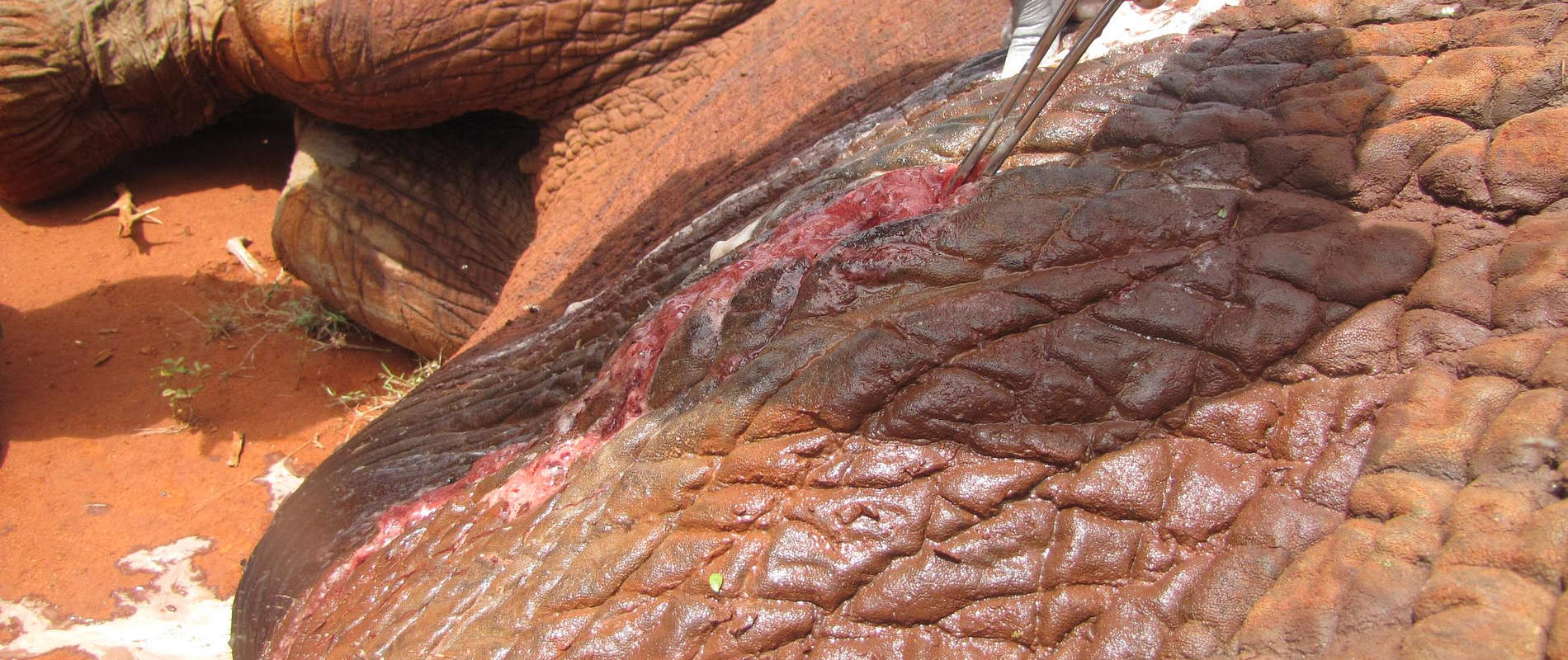FIELD VETERINARY REPORT FOR TSAVO MOBILE VET UNIT FOR THE MONTH OF APRIL 2016 Reported By Jeremiah Poghon Introduction During April, the Tsavo vet unit covered for the Amboseli vet unit that was away on annual leave
FIELD VETERINARY REPORT FOR TSAVO MOBILE VET UNIT FOR THE MONTH OF APRIL 2016
Reported By Jeremiah Poghon
Introduction
During April, the Tsavo vet unit covered for the Amboseli vet unit that was away on annual leave. Cases handled by the unit in the Tsavo and Amboseli ecosystems during the month included treatment of two elephant bulls with spear wounds in Amboseli National Park and OldonyoWuas lodge in the Chyulus. Two lionesses were also collared with satellite linked collars for monitoring and mitigating chronic livestock predation in Kuku Community Conservancy. Other cases handled were the autopsy of anelephant carcass in Choke ranch area and treatment of a bull with arrow wound at KMC ranch, Buchuma just outside the southern park boundary.
CASE#1 AUTOPSY OF AN ELEPHANT CARCASS
Date: 1st April 2016
Species: Loxodanta Africana (African Elephant)
Sex: Female
Age:Adult
Location:Choke ranch, Taita Ranches
History
A report was made by KWS rangers regarding the discovery of an elephant carcass inside Choke ranch that forms part of the bigger Taita ranches. The cause of death was unknown. The vet team was tasked with undertaking an autopsy to determine the cause of death.
Autopsy
The carcass was lying on the right flank with tusks missing (earlier removed by KWS rangers); there was sign of ante-mortem bleeding on the body surface.
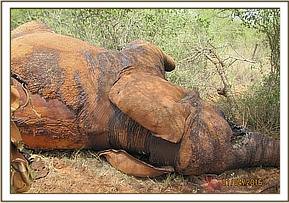

External examination did not reveal any visible wound. The skin was removed on the left flank and towards the spinal area for examination of any underlying injuries. Large amounts of ingester (food materials) were observed immediately under the skin near the lumbo-sacral area. The finding was abnormal and significant as there was a perforation of the muscles that not only cut through the muscles but also punctured the great colon. Massive peritonitis was also observed in the peritoneal cavity. Closer examination revealed a deeply embedded sharp arrow head between the muscle tissues. The arrow head was recovered.
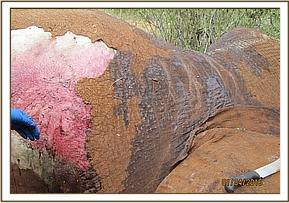

Results
Cause of death was by arrow shot that penetrated the peritoneal cavity and ruptured the colon causing massive peritonitis and death.
CASE#2 LION COLLARING EXERCISE IN KUKU RANCH
Date: 2nd to 5th April
Species:Lion (2)
Sex: Male and Female
Age: Adult
Location: Kuku ranch
History
Kuku ranch is a community conservation area bordering Tsavo West National Park and Chyulu National Park. Human predator conflict is high in the mainly pastoralist community that keep livestock as their main economic activity. There was increase in livestock predation by lions recently that lead to protest by the community and the killing of one lioness and injuring of several people. Discussion between the park warden, community representatives and the unit resolved to collar the problematic lions for easy monitoring and assist in conflict mitigation.
Immobilization and collaring
The lion was immobilized using 300 mgs of ketamine and 4 mgs of meditomidineHcl after responding to a calling station near one of the hotspots; another dart was added to fully immobilize the lion.


The lioness was immobilized the night after; also responding to a calling station by aid of night vision equipment.
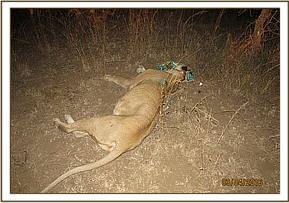

The collars were fitted with enough space to allow the lioness to feed and move with ease.
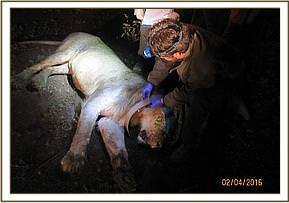
The lion’s were revived approximately 1.5 hours later using 0.5 cc Atipemazolehcl and monitored until they moved away on their own. Further follow up reports indicate they are doing well with the satellite component sending signals.
CASE#3 EXAMINATION OF A WILD DOG CARCASS
Date: 7th April
Species: African Wild Dog
Sex: Male
Age: Adult
Location: Tsavo River along the Nairobi- Mombasa highway
Examination
While travelling along the busy Mombasa- Nairobi highway the vet unit came across a dead African wild dog lying beside the road with visible blood stains draining from the still body.
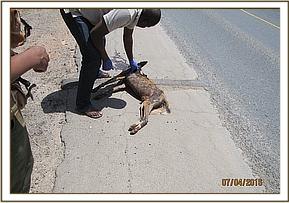
Closer examination revealed the dog was already dead and had multiple fractures of the femoral bones and the pelvic frame. The injuries were linked to road accidents by the speeding vehicles along the busy road. Wild dogs are endangered and only small numbers still exist in the wild.
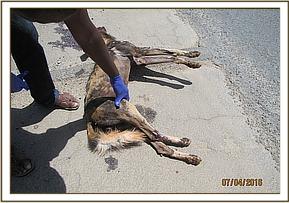
CASE#4 TREATMENT OF AN INJURED ELEPHANT BULL
Date: 10th April
Species: Loxodanta Africana (African Elephant)
Sex: Male
Age: Bull
Location: OldonyoWuas, Chyulu National Park
History
The elephant bull was spotted near a watering point in OldonyoWuas by Big life rangers from Mbirikani Ranch with wounds to the right rump discharging pus. They notified the vet team who were immediately airlifted to the area using DSWT airplane.
Immobilization, examination and treatment
The vet prepared a dan-inject dart with 19 mgs of Etorphine and attempted to dart the elephant from both the vehicle and from foot. However, this was impossible so the the DSWT helicopter was called in to assist and arrived after 45 minutes.
The helicopter was used to approach the bull which had moved away after hearing the chopper noise. He was darted in the rump and kept in the open for up to ten minutes but ran into the bush despite spirited efforts by the helicopter pilot. He ran for nearly 2kms before going down after record 18 minutes.
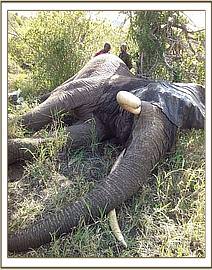

The elephant had two spear wounds, one to the right rump and the other at the base of the trunk.
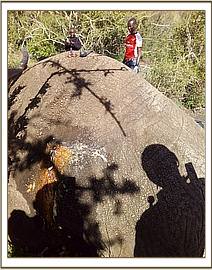

The necrotic tissues were cut away and the pus removed when the wound was cleaned using water mixed with Hydrogen Peroxide. Tincture of iodine was then applied and Oxytetracycline spray administered before the wounds were finally covered with wetted green clay.
The elephant was given an intravenous administration of 50 cc Dexamethasone Hclthrough the ear vein and 200 cc of long acting Amoxicillin was injected intramuscularly.
Reversal
Drug reversal was acheived by administration of DiprenorphineHcl at three times the Etorphine dose.
Prognosis
The bull woke up and moved away slowly. Prognosis is good.
CASE#5 TREATMENT OF AN INJURED ELEPHANT BULL
Date: 11th April
Species: Loxodanta Africana (African Elephant)
Sex: Male
Age: Bull
Location: Kimana gate, Amboseli National Park.
History
The elephant bull was spotted near Kimana gate area by KWS rangers from the Amboseli platoon with wounds to the foot. They notified the vet team who were immediately airlifted to the area using DSWT helicopter to find the injured bull foraging nearby.
Immobilization, examination and treatment
The elephant was immobilized using 20 mgs of Etorphine in a dan-inject dart. Avehicle was used to trail the bull who had moved away after seeing the vet vehicle. He was darted in the rump and kept in grassland by the vehicle. He went down after 12 minutes.
There was one penetrating spear wound on the lateral aspect of the front right foot going through to the sole. The wound was cleaned using water mixed with hydrogen peroxide and the necrotic tissues were cut away. Tincture of iodine and Oxytetracycline spray were administered before the wound was covered with afinal cover of wetted green clay.
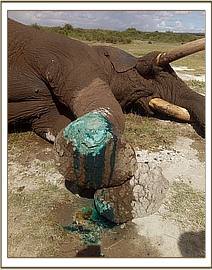

An intravenous administration of 50 cc Dexamethasone Hcl was given through the ear vein and 200 cc of long acting Amoxicillin was injected intramuscularly.
Reversal
Drug reversal was acheived by administration of DiprenorphineHcl at three times the Etorphine dose. The bull woke up and moved away slowly.


Prognosis
Repeat treatment was advised after one month.Prognosis is good
CASE#6 TREATMENT OF AN INJURED ELEPHANT BULL
Date: 25th April
Species: Loxodanta Africana (African Elephant)
Sex: Male
Age: Bull
Location: KMC ranch Bachuma, Tsavo East National Park.
History
The elephant bull was spotted in KMC ranch just outside the Bachuma –Dakota fence boundary by DSWT aircraft while patrolling the area. The team moved to the area aided by the DSWT chopper to try to drive the elephants back to the park and then treat the injured bull. Despite several attempts by the helicopter the elephants refused to cross the fence line even after the wire was removed and the elephants separated making the drive impossible. The team decided to embark on the treatment of the bull.
Immobilization, examination and treatment
The elephant was immobilized with 18 mgs of Etorphine in a Dan-inject dart. The chopper was used to approach the bull who had moved away after hearing the noise from the chopper. He was darted in the rump and kept in a less bushy areaby the helicopter. He went down after 10 minutes.


There was one penetrating arrow wound to the left abdominal wall discharging pus and very swollen. The wound opening was enlarged, dirt materials and pus were cleaned out, necrotic tissues cut off and the wound cleaned using water mixed with hydrogen peroxide.
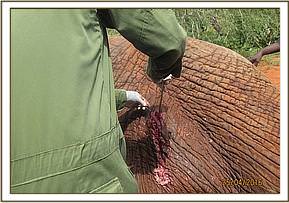
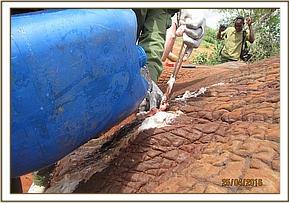
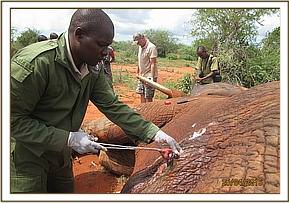

Tincture of iodine was applied and Oxytetracycline spray administered before a final cover of wetted green clay was applied. An intravenous administration of 50 cc Dexamethasone Hcl was given through the ear vein and 200 cc of long acting Amoxicillin was injected intramuscularly.


Reversal
Drug reversal was done by administration of DiprenorphineHcl at three times the Etorphine dose. The bull woke up and moved away slowly.
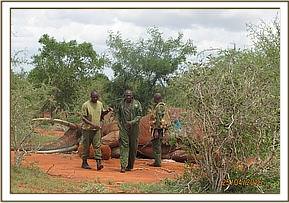

Prognosis
Repeat treatment was advised after one month. Prognosis is good
Acknowledgement
The unit would like to appreciate the support of its sponsors ViER PFOTEN through the David Sheldrick Wildlife Trust (DSWT) for their continued support. We also thank Kenya Wildlife Service through the Assistant director Tsavo conservation area and the head,veterinary and capture services department for their immense support to the unit.
